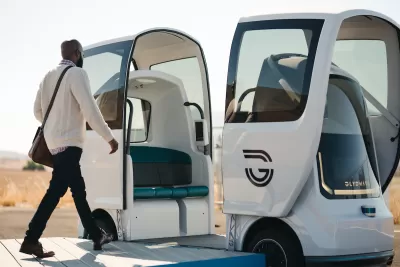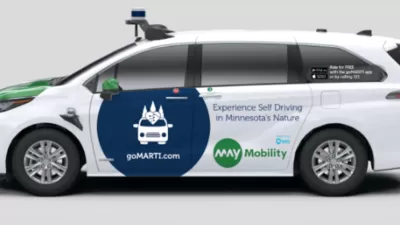The autonomous, four-person pods would travel on an enclosed track, but is it an effective model for public transit?

An autonomous car company wants to bring driverless, four-person ‘pods’ to the Bay Area, reports John Ramos for CBS News, a project that would require a 28-mile enclosed roadway with 56 access points. “And because the cars are only about five feet wide, the travel route is small enough to run alongside trails, railroad tracks and streets without removing any existing lanes.”
The service, built by Glydways, could provide a link to Bay Area Rapid Transit (BART) and other regional transit systems for communities that lack connections. “So where will the money coming [sic] from? Right now, that's unclear. But transit planners say it will be a partnership, combining state and federal funding with private investment.”
High-tech transportation projects like this have been criticized for distracting transportation agencies and lawmakers from the less flashy transit solutions — e.g. buses — that have been proven to work when funded effectively.
FULL STORY: Autonomous car company Glydways to bring driverless public transit to East Contra Costa

Study: Maui’s Plan to Convert Vacation Rentals to Long-Term Housing Could Cause Nearly $1 Billion Economic Loss
The plan would reduce visitor accommodation by 25,% resulting in 1,900 jobs lost.

Alabama: Trump Terminates Settlements for Black Communities Harmed By Raw Sewage
Trump deemed the landmark civil rights agreement “illegal DEI and environmental justice policy.”

Why Should We Subsidize Public Transportation?
Many public transit agencies face financial stress due to rising costs, declining fare revenue, and declining subsidies. Transit advocates must provide a strong business case for increasing public transit funding.

Paris Bike Boom Leads to Steep Drop in Air Pollution
The French city’s air quality has improved dramatically in the past 20 years, coinciding with a growth in cycling.

Why Housing Costs More to Build in California Than in Texas
Hard costs like labor and materials combined with ‘soft’ costs such as permitting make building in the San Francisco Bay Area almost three times as costly as in Texas cities.

San Diego County Sees a Rise in Urban Coyotes
San Diego County experiences a rise in urban coyotes, as sightings become prevalent throughout its urban neighbourhoods and surrounding areas.
Urban Design for Planners 1: Software Tools
This six-course series explores essential urban design concepts using open source software and equips planners with the tools they need to participate fully in the urban design process.
Planning for Universal Design
Learn the tools for implementing Universal Design in planning regulations.
Smith Gee Studio
Alamo Area Metropolitan Planning Organization
City of Santa Clarita
Institute for Housing and Urban Development Studies (IHS)
City of Grandview
Harvard GSD Executive Education
Toledo-Lucas County Plan Commissions
Salt Lake City
NYU Wagner Graduate School of Public Service





























